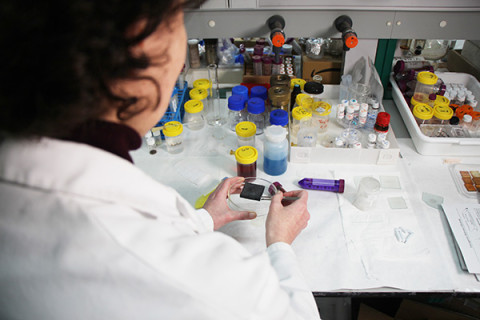Researchers create graphene-like materials with biomass and clay to boost the energy transition

Researchers from the Materials Science Institute of Madrid (ICMM-CSIC) are leading an international study in which they have managed to optimize the preparation of solids with a graphitic structure through sepiolite, a very abundant clay in the Tajo watershed. The work, published in the journal Carbon, has proposed the formation mechanism of these materials, so their production is scalable for applied use in electronics.
If graphene is one of the most desired materials due to, among other things, its high conductivity and resistance, graphitic materials are also so to the extent that they share many of their characteristics with graphene, although with an 'imperfect' internal structure. . Although obtaining these graphitic elements is simpler than conventional graphene production, this process usually requires processes at very high temperatures, which results in long working times and significant energy expenditure. This work provides a solution to this in an optimized way.
"We have used different experimental synthesis strategies at relatively low temperatures to obtain these materials, similar to graphene, using a microporous sepiolite clay," explains Eduardo Ruiz-Hitzky, ICMM-CSIC researcher and coordinator of the work. This team has chosen this material (sepiolite) because of its abundance on the peninsula and its low cost, but also because they have seen that the clay itself 'imposes' the ordered structure of the compounds of this new material.
For this work, sucrose – table sugar – has been used as a model, but it can be extended to any type of biomass. "If you heat sugar and make caramel, when you thermally treat that material you do not form graphitic compounds, but with the sepiolite as a support, it imposes that internal structure," details Ruiz-Hitzky. "When you heat the source material in the presence of the support, compounds are formed that remain absorbed and they are the ones that reorganize to give the structure of a non-perfect graphene," adds Margarita Darder, ICMM-CSIC researcher and another author of the study.
Sepiolite also makes the process sustainable. "We managed to spend less energy thanks to it," adds Pilar Aranda, ICMM-CSIC scientist and author. Not only that, but this result combines the best of both source materials: "It is better handled, it has a porosity that can be used for successive applications since it is an adsorbent and a conductor at the same time," describes Ruiz-Hitzky. "It is so well structured that, although it has traces of that sepiolite that does not conduct electricity, the material is conductive, and is suitable for most applications," adds Aranda.
When it comes to mentioning applications of this material, the list seems endless: "obviously it is not a perfect graphene, but it can be used for lithium battery electrodes, supercapacitors, or even for hydrogen storage," say the three. "We have also done tests for electrochemical sensors or sensors that respond to pressure in motion. All of these topics are fundamental for energy and are sustainable and economical," concludes Ruiz-Hitzky.
This work has been prepared in collaboration with the University of Aveiro (Portugal) and has formed part of the Doctoral Thesis carried out by Ana Barra between both institutions, where she has achieved the highest qualification. The Polytechnic University of Bucharest and the Academy of Romanian Scientists (Romania) and the Autonomous University of Madrid (Spain) have also participated in this collaboration.
A. Barra, O. Lazăr, G. Mihai, A. Bratu, C. Ruiz-García, M. Darder, P. Aranda, M. Enăchescu, C. Nunes, P. Ferreira, E. Ruiz-Hitzky: Graphene-like materials supported on sepiolite clay synthesized at relatively low temperature, Carbon, DOI: 10.1016/j.carbon.2023.118767
Instituto de Ciencia de Materiales de Madrid (ICMM)
Sor Juana Ines de la Cruz, 3
Cantoblanco, 28049
Madrid, España
Telephone: (+34) 91 334 90 00
Email: @email
Communication Office: @email

Acknowledge the Severo Ochoa Centres of Excellence program through Grant CEX2024-001445-S/ financiado por MICIU/AEI / 10.13039/501100011033

Contacto | Accesibilidad | Aviso legal | Política de Cookies | Protección de datos